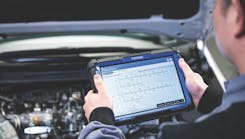Tech Tip: An overview of different lift types
Following is an overview of the different types of vehicle lifts.
Four-Post Automotive Lifts
This is the wheel-engaging type auto lift, also known as a type of alignment lift.
Four-post automotive lifts are the most common solution used in the automotive repair industry. Due to the additional support given by four posts, these lifts are known to be sturdier than their counterparts, two-post lifts.
Some four-post home automotive lifts require no anchorage to the floor. They can be moved with relative ease when needed, using manufacturer-supplied casters. This makes them a popular choice for some hobbyists and homeowners, as their placement is not "set in concrete" and one can always move them temporarily if needed. They can also be used for storage, for example, when stacking two cars in one spot.
Four-post lifts are usually priced slightly higher than the two-post lifts, due to the extra mechanics and materials involved in manufacturing them.
Two-Post Automotive Lifts
Two-post lifts are the best-selling "frame-engaging" lifts. They are recommended as the "drive-through" garage solution – drive it in, lift it, fix it, put it down, and drive it out.
There are two types of two-post lifts on the market: symmetric lifts and asymmetric lifts.
They both work great. However, with a symmetric two-post lift, one needs to take care not to bump the car doors after one has driven the vehicle into position for the lift. There's only so much space available to open the doors between the posts. It's not a problem provided the user stays alert of what's happening while working with the lift. There are also wider symmetric two-post lifts available on the market that address this problem.
Asymmetric lifts are specifically designed to handle the problem of accidentally denting car doors. Their posts have been rotated at 30-degree angles of each other and the front arms are shorter than the back arms – this balances the car's weight distribution so the user doesn't have to worry about denting the doors (the user stops the car about one third the way in, in as opposed to half-way between the posts – eliminating car-door dent syndrome).
With all that in mind, the biggest advantage of having a two-post car lift is that it works out cheaper than a four-post lift and still provides full access to the wheels (as well as the rest of the car body).
Automotive Scissor Lifts
Scissor lifts are named as such because they raise vehicles with an accordion-like mechanism beneath the runways; a metal frame of Xs joined to raise the platform on which the vehicle is standing.
Scissor lifts come in a variety of capacities and heights for both home and professional automotive repair shops, and are quite capable of lifting very heavy vehicles. From a low height of three feet to anything beyond that. They are built as both wheel and frame engaging models.
When the scissor lift is not lowered and in use, it is much more pleasing to the eye than the four-post lift, as it shrinks itself to the ground.
Portable Automotive Lifts
Space is always an issue and that is where portable automotive lifts come in. Want to pack a lift away when done sorting out the car? A portable automotive lift is the answer.
Portable auto lifts are an efficient solution for the home or for the small businesses. They have a limited lift capacity, so if they are used for business, be aware that they can't lift larger, heavier vehicles. Be sure to check the capacity of these lifts for their intended uses.
Either way, portable auto lifts, such as two-post MaxJax lifts, are very popular and are a great solution when space is an issue. They are also available in four-post, scissor, and even single-post models.
In-Ground Auto Lifts
For many years, in-ground auto lifts were the industry standard for car and truck lifting. The best feature being that they can be kept down low on the floor of the repair facility when they aren't being used.
Depending on the design, in-ground auto lifts can be either frame or wheel engaging.
In-ground auto lifts are generally more expensive than other lifts, and there is also the cost of the installation which has to be taken into consideration.
Alignment Auto Lifts
The alignment automotive lift has runways which the vehicle is driven onto. It is a special type of lift because it comes with extra features that make it easier to perform alignment services on cars and trucks. Special turn-and-slip plates are built into the runways to allow the wheels to easily turn without resistance. This type of lift is also called a "wheel engaging lift".
Mobile Column Auto Lifts
Mobile column lifts are wheel engaging lifts. The user wheels the column in place by a wheel (for every wheel of the vehicle) and they lift your car simultaneously for an even lift. Each column is a completely separate unit and when put in place at each wheel work together to lift the vehicle. These generally heavy duty lifts are not a typical homeowner's choice.
Parking Lifts
Public or private parking benefit from parking lifts. The idea being that a single parking space – given enough room vertically - can be occupied by two cars. These lifts are smaller than four-post lifts as they generally use one or two posts and have a lifting platform under the car that prevents fluids from leaking onto a vehicle parked underneath it; therefore, these lifts cannot be used to repair a car from underneath.
Information provided by: Dannmar Equipment

